It was always a dream of ours, turns out even before we were together. This year we finally did it. Here’s our story…
It was November 2018 when we started exploring going solar. I was curious about what it would cost, so I was playing around with an online calculator when Travis at Great Basin Solar popped in on my screen and asked if he could answer some questions. In the end we decided it was best if he came out and talk with us, looked at our home and modeled a possible system. He assured me he was no pressure and would respect our desire to wait. He did let us know that waiting might mean lower rebates, tax incentives, and a higher grid storage tariff with NV Energy.
We sat down with him on November 29th. He had already passed by the house and worked out a tentative design for our south-facing roof. He’d been in touch with Scott and put one year of our electric bills into his model. We told him we’d eventually like to add an Electric Vehicle (EV) and asked him to include that in his design.
Here is his model for what our solar system would generate (orange) laid over one year of our historical electricity use from our bills + projected needs for an Electric Vehicle (blue):
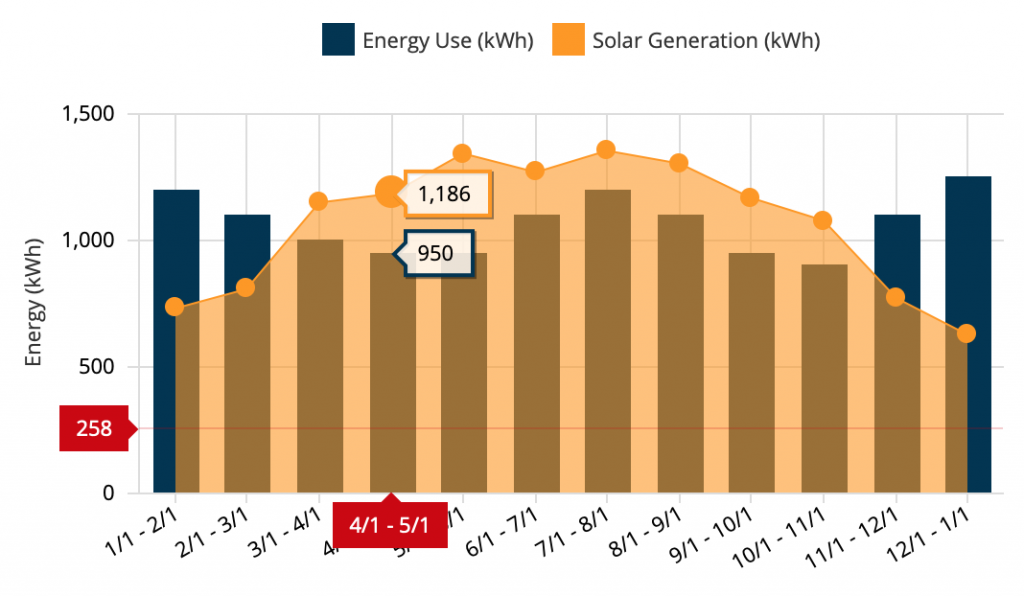
This model assumes we use about 19 kWh (kilowatt hours) per day of electricity on average in our home + an average EV usage of 12 kWh per day factored in. At 31 kWh per day, we’d need to generate 950 kWh or approximately 1 megawatt per month.
Travis is very bright and easy to follow. He and his team are all highly certified with 35+ years of experience in the solar field. He explained, in just enough detail, his proposal and how the system would provide our electricity. Any excess storage would go back into the grid and NV Energy would credit us for it, less a 12% tariff. We could tap into that storage in the months we would not generate enough of our own electricity. He went over all the rebates and incentives that would bring down the cost. He suggested we go with 22 panels and a SolarEdge Inverter with an EV charger attached directly to the inverter. Total bottom line price: $15,000.
I remember asking, “Excuse me, did I hear you right? Did you say 15 or 50 thousand dollars?” He assured me he’d said 15. He also told us that adding a solar system, increases a home’s value by an average of 3%. After he left, Scott and I talked it over. We looked at each other and said, “Well that’s a no-brainer. Let’s do it!” Neither of us could believe how inexpensive the system was going to be, and it would be virtually paid for by the value it added to our home as soon as it was installed! We couldn’t think of a reason to wait and there were several reasons not to. Those reasons included declines in rebates over time and that the NV Energy tariff for storage goes up as the number of installed solar systems increase. So we called Travis and told him to book us in.
In January, his team of two installers came to our home. They were wonderful to work with, plus they played great 80’s music! Scott has most of a degree in Electrical Engineering and takes great pride in the electrical system he has installed in our home. He is VERY PARTICULAR about what goes on with this system, and he was super impressed with these guys and their work. It’s clean, safe, efficient and well designed. They completed the job in two days!
We can’t say enough good things about working with Great Basin Solar and Travis and his team! These guys know what they are doing. We referred several of our friends to them and they are equally impressed. Most of them are moving forward with their own installations. Though his business is new, he and his team have more certifications and experience than most solar companies in Nevada. He is a local guy and plans to stay in Reno for a long time. He guarantees his work and the panels for 25 years! You can find out more at: https://www.greatbasinsolar.com/.
Here’s our panels after they were installed (from our neighbors’ 2nd story):
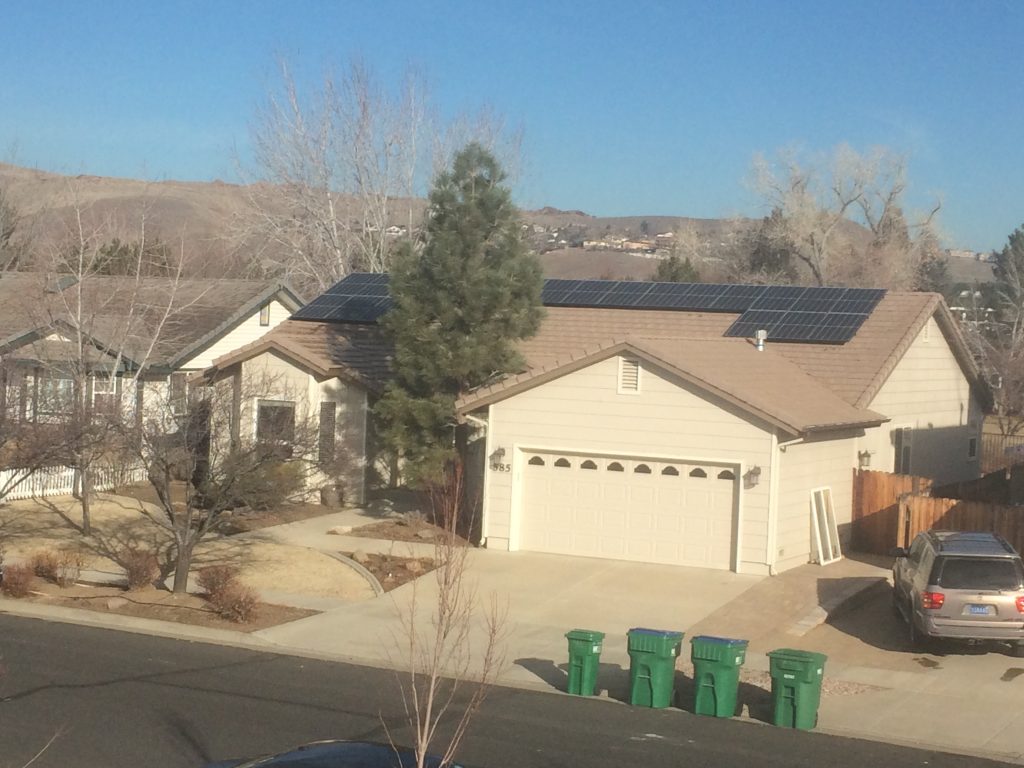
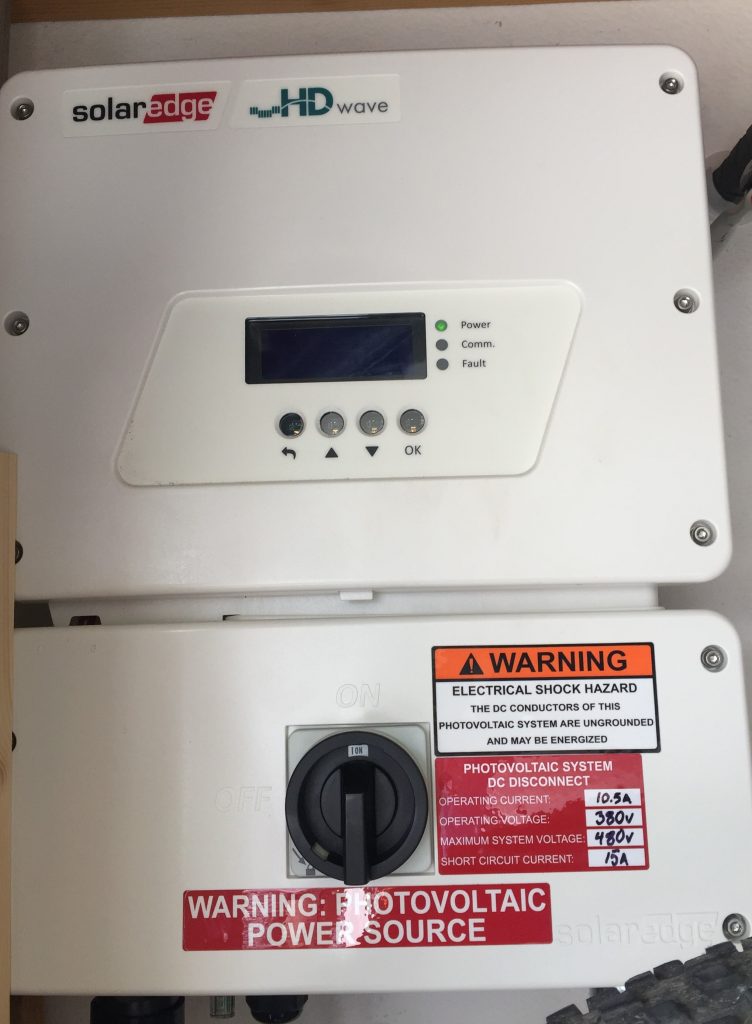
Then came the wait for NV Energy to hook us into the grid. That took about a month. On February 19, 2019 we went LIVE! It’s been fun watching our power production with the SolarEdge (SE) apps and maybe a little less fun figuring out the NV Energy bills… In the next entries, I’ll put in copies of our NV Energy bill and the SE stats on what our system has generated so you can follow along with a live example of solar power at work!
The Cars
Along with always wanting solar, we have also been interested in reducing our carbon footprint by getting more fuel efficient cars. When our neighbor got a LEAF and then a Tesla, we watched with curiosity, took rides, and fantasized. One day in the future, we would drive an EV, maybe first we’d get a hybrid.
In fall 2018 we started to notice that Scott’s 2002 Toyota 4-Runner with 175,000 miles was developing a serious vibration when going downhill and braking. We decided it was time to get a new SUV to tow our teardrop trailer before our 2019 camping season began. Scott was interested in the Toyota Highlander Hybrid, which one of his friends had. We started checking prices online and realized that used Highlanders are about as expensive as new ones. We also discovered the best day to buy a new car is New Years Eve. So after lunch on December 31, 2019 we went down to Dolan Toyota to look at Hybrid Highlanders.
2019 Toyota Highlander Limited
When we walked on the lot, we were greeted by a young man named Weston who announced that the dealership was in the last hours of vying for an important award from Toyota for being among the top 60 dealers in the nation for 2018. This is a BIG deal for little Reno and they had succeeded the year before. No one thought they could do it again, but they were in the running. Toyota would not tell them how close and they were. Turns out the advice we received online about New Year’s Eve was right on!
We told Weston we wanted a white Toyota Highlander Hybrid, not too fancy and we could wait. Understandably, he wasn’t too excited about this. He didn’t have any of those on the lot. But he did have a Limited model, would we like to look at it? We told him there was no way we could afford it, but he could take us for a drive if he wanted to. So he did.
WOW!!! What an amazing ride! Luxurious, quiet, smooth and very fast. It was my first experience in a V-6 hybrid with AWD. It has one electric motor to drive each axle (front and rear) and a gasoline engine, along with a battery. The battery is recharged by both the gasoline engine and braking. When first accelerating, coasting or braking, the batteries provide power to the electric motors. When accelerating harder, the engine takes over. It has a continuous transmission that makes gear shifting almost imperceptible. We both drove it and were so impressed!
Here’s a great little video and explanation of how a hybrid Toyota works:
https://www.markjacobsontoyota.com/toyota-hybrid-faqs.html .
But it wasn’t in our price range. Weston said, “Let me talk to my manager and see what we can do for you today.” Somehow they managed to get us into this beautiful car for a price we could afford! And we were among the last 5 cars that put Dolan Toyota over the top for their award! We figured, in the end, we all won. We can definitely recommend Dolan Toyota in Reno if you are looking to buy a Toyota.
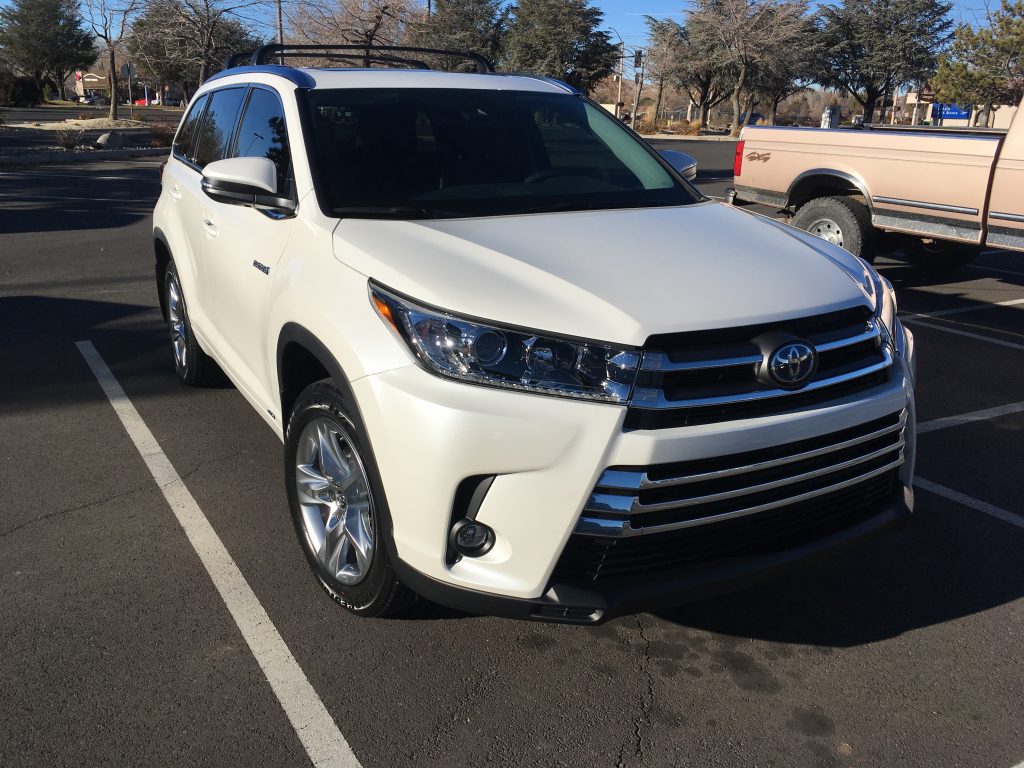
As of this writing, we’ve had the car for 6 months and we love it! It gets about 30 MPG, double the 4-Runner. So we’ve cut our emissions by about half, along with our gas bill. What’s not to love? It’s more powerful, faster and smoother than the 4-Runner and way more comfortable with all the modern features, including heated and air conditioned front seats and seamless links with our iPhones. In addition it sports a host of safety features including: lane departure and blind spot alerts, automatic 3-car-length adjustment on the cruise control, and a great backup camera that flashes if there is someone behind you. This results in it being the same cost to insure as the old 4-Runner! We use about a tank of gas a month and it is a perfect car for road trips (no gas stops, since it goes 450 miles between fills and our behinds can’t last longer than that). We are excited about using it to tow our teardrop this summer! Stay tuned for how that goes…
We also understand that it will require less maintenance than a regular ICE (internal combustion engine vehicle). And since we always drove old vehicles with 100,000+ miles on them, it will be a lot less than what we are used to!
What we used to pay on average per month: $75 for repairs and maintenance/$100 for gas. Total $175.
What we expect to pay with our new Hybrid: $50 for repairs and maintenance/$50 for gas. Total: $100
Savings per month: $75
I’ll put up a blog post annually to keep you updated on how it actually turns out! And keep you updated on our Teardrop Travels.
2016 Nissan LEAF SV
In March, we took my 2012 Subaru Forester in to check an exhaust smell in the cabin. The muffler shop called us back a few hours later and said, bad news the muffler and catalytic converter are shot, it’ll cost you $1800 to fix it! The car had nearly 140,000 miles on it and we just couldn’t see spending that kind of money to fix it.
Add to that the fact that on some days we were generating 50 kWh of solar power on our roof and it was only March! We use about 19 kWh per day on average in our home, so it was very clear to us that we were generating way more electricity than we would ever use.
Maybe it was time to get an electric vehicle (EV) sooner rather than later… We had thought about a Tesla, but that was out of the question after the Highlander. So we started exploring other options and discovered that used Nissan LEAFs are INCREDIBLY CHEAP!
This is a fun read on that subject: https://jalopnik.com/holy-crap-used-nissan-leafs-are-incredibly-cheap-1743475298.
Bottom line is the older models don’t have the range of the newer models and with EV’s, it’s all about range. But there is this cool sweet spot in the 2016 and 17 LEAFs, which have a higher capacity battery giving around 100 miles of range. We decided we wanted a white 2016-17 SL or SV LEAF. (LEAF is an acronym for Leading Environmentally-friendly Affordable Family-vehicle. It is the top selling EV in the world.)
Ok, I admit I got totally obsessed with it! I HAD to have a LEAF. So I hunted online using CarGurus looking for a Great Deal (that’s how they label them), and I found one. A pretty 2016 SV with only 23,000 miles for $13,000! I could not believe it. The bummer was it was in the Bay Area. After vetting the car the best we could long distance, we flew down to pick it up on April 3, 2019.
It took us 8 hours to make the 4-hour drive back to Reno. Because we were EV newbies with a major care of Range Anxiety, we stopped to charge 4 times for about 30 minutes each. That was an interesting experience!
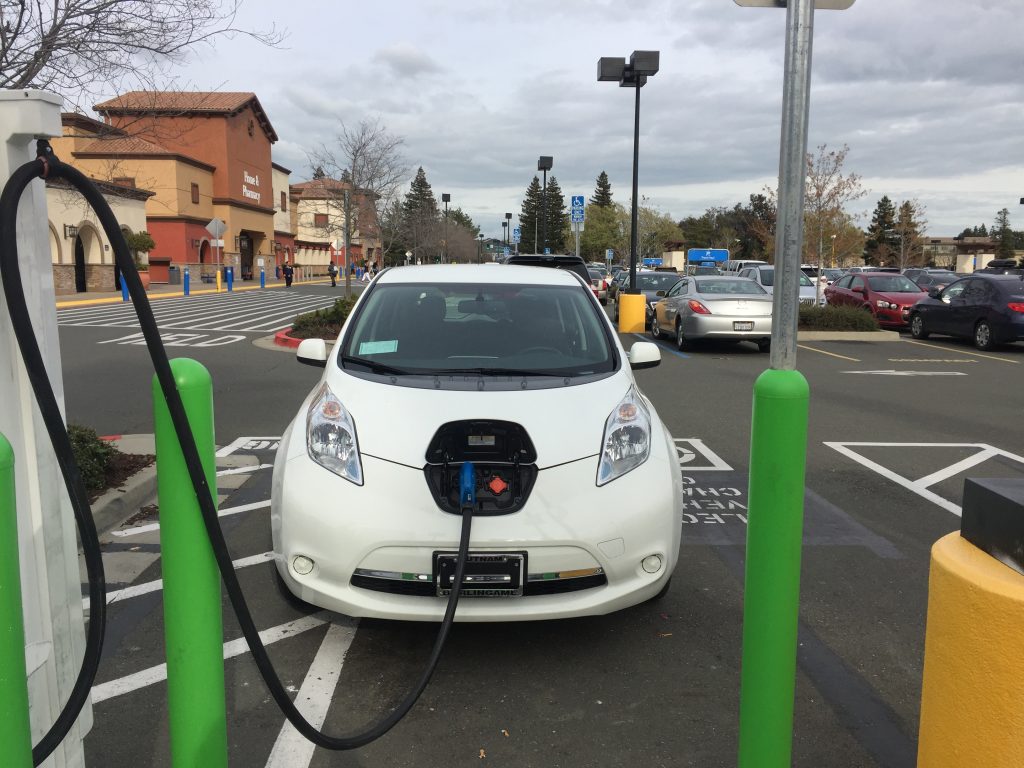
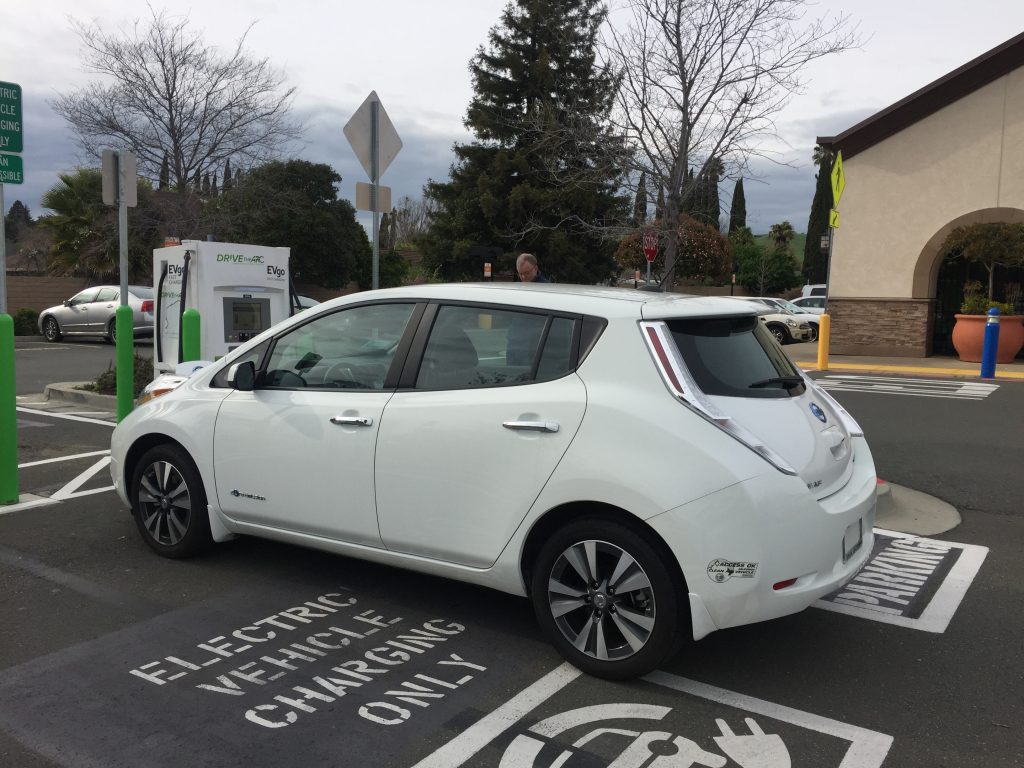
We used quick chargers from an app on the iPhone called Drive The Arc. Most of them were in grocery store parking lots or Walmarts. We learned the LEAF sucks lots of energy going uphill with the headlights and heat on–all of which take electricity. The total cost for the trip was about $35. What we didn’t know is that when you do that many quick charges in an 8-hour period, the battery heats up! We drove the last leg home from Truckee in the red zone and tried not to worry. Fortunately, we made it back without a problem and the battery cooled down overnight. Ok, it’s definitely not a road car.
Turns out it is an awesome in-town car. It is super fast and silent–makes a cool spaceship-like sound during acceleration and softly pings when you back up. The acceleration is exhilarating! There is no transmission in the LEAF so it is pure power to the wheels. The battery sits in the center of the vehicle, giving a low center of gravity so it handles like a sports car. It is the size of small sedan and amazingly comfortable. It includes heated seats and steering wheel and the ability to link to our iPhones, though that link is not as sophisticated as the Highlander’s. It also has a backup camera and a deep, roomy trunk. It costs about the same to insure as my old Subaru. I always wanted a VW Bug and the LEAF reminds me of that design. I think she’s adorable! Ok, so I’m in total love with our new car! And the best part is she is powered by Nevada sunshine and has zero emissions.
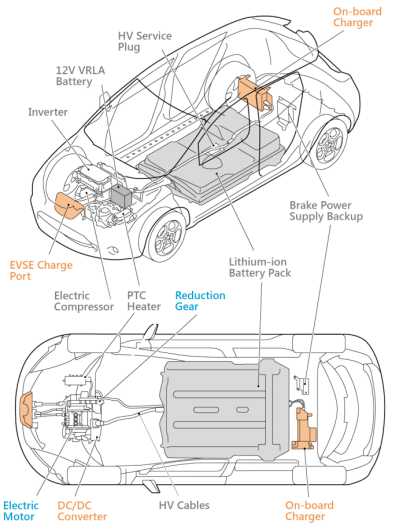
The charger is attached to the solar inverter in our garage, so we plug her in like a cell phone. We get about 100 miles out of a full charge, but usually keep her at 30%-80% to save wear on the battery. For our normal in-town use, we plug in about every 2-3 days for a couple of hours.
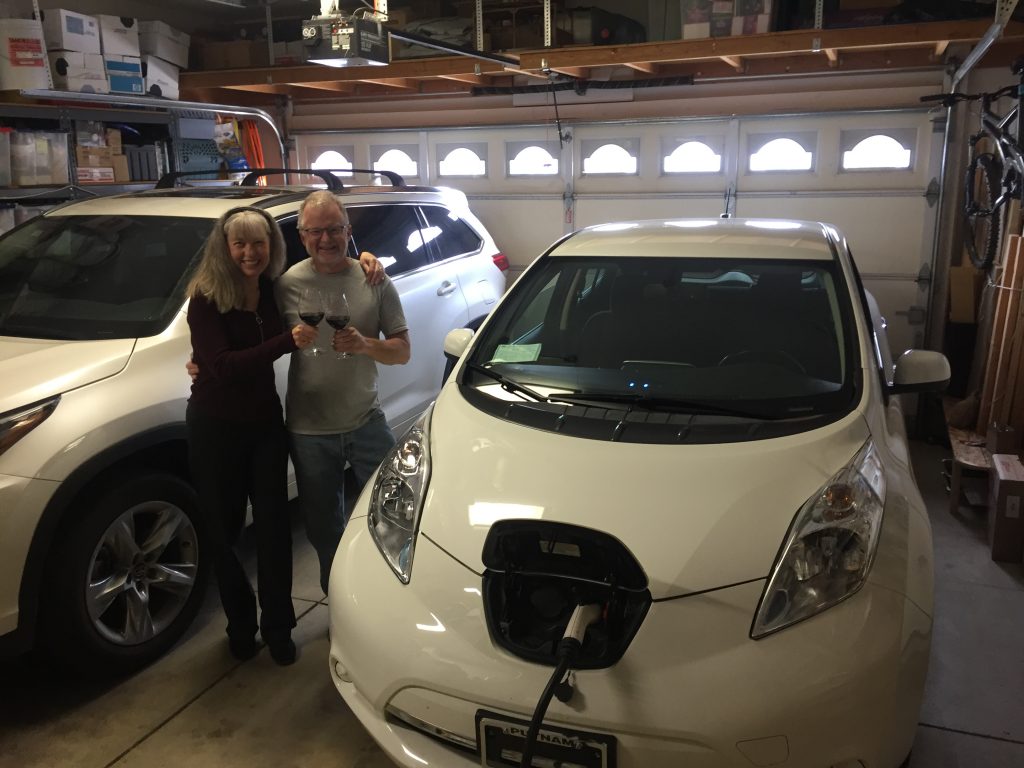
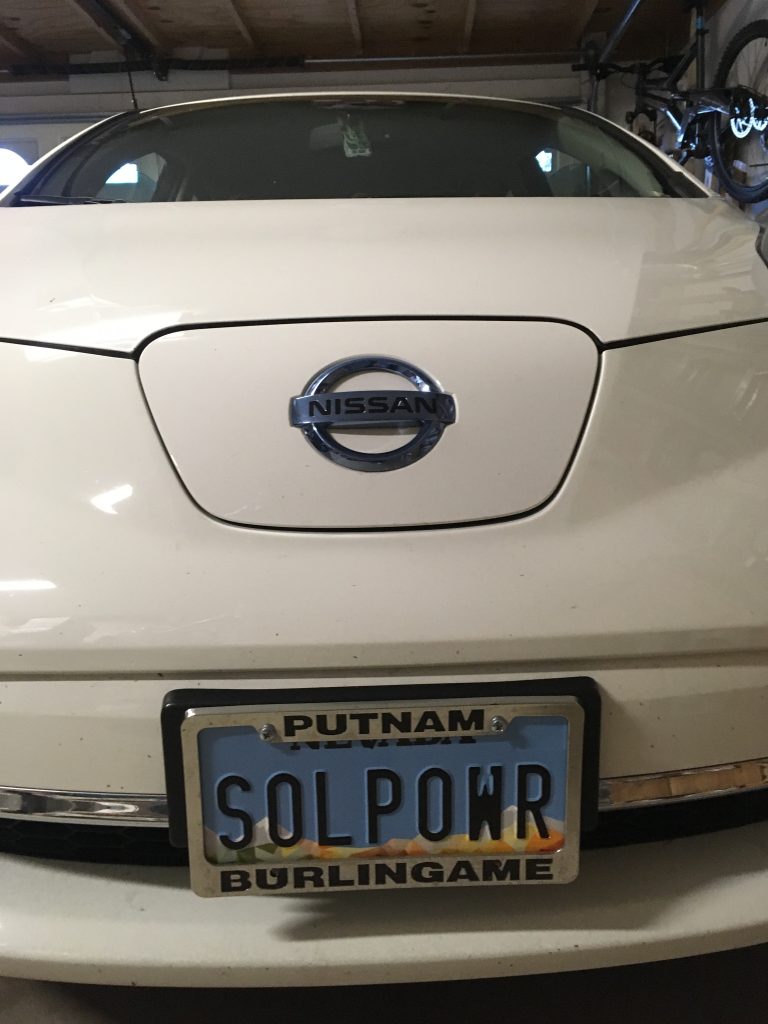
We hear that EV’s require even less maintenance than a hybrid, maybe 1/3 of the cost, since there is no engine or transmission, and a lot less fluids. This assumes we will get another EV rather than replace the battery, which is guaranteed for 100,000 miles, but can last a lot longer than that.
For the Subaru, we used to pay on average per month: $75 for repairs and maintenance/$85 for gas. Total $160.
What we expect to pay for the LEAF: $25 for repairs and maintenance/$0 for gas. Total: $25.
Savings per month: $135
I’ll add the stats on the electricity the LEAF uses monthly and put up a blog post annually on the maintenance costs to keep you updated on how it actually turns out!
Savings Expected from Going Solar, Hybrid and EV
Savings per month from Hybrid: $75
Savings per month from LEAF: $135
Savings for electricity: 19 kWh average per day X $.09/kWh = $51
Total Savings: $261/month
Savings Related Directly to Solar System & EV: $186
Estimated time until we get our money back on solar system & EV: ($15,000+$13,000-$4,000 for Subaru)/$186/12=10.75 years. (Of course, in reality we got the money back immediately for the solar system in increased home value.)
Honestly, for us the breakeven point is less important than knowing we are doing something kind for mother nature at a time when She desperately needs it. The extra bonus is how fun it is to drive the cars of the future!
I’m impressed with how well you did your homework regarding both the solar energy and hybrid cars. This is the ideal area for solar energy. Unfortunately, it doesn’t work so well in places like my home state of Michigan, where the sun may not shine for days or weeks. But, here……..it is a natural. YAAAAAAAAY! If Mike and I were younger and if we were going to stay in this house for years, it would pay off for sure. Excellent decision for you two. The hybrid cars remind me of my uncle in the 1960’s. He built his own electric car and drove it back and forth to work every day. He had that car for years and loved it. That was the beginning of this concept and am glad to see it has prevailed. Keep up the good work!!
Thank you for your great comment, Marlene! Fun story about your uncle’s car. Yes, we are so thrilled with how this is all turning out!